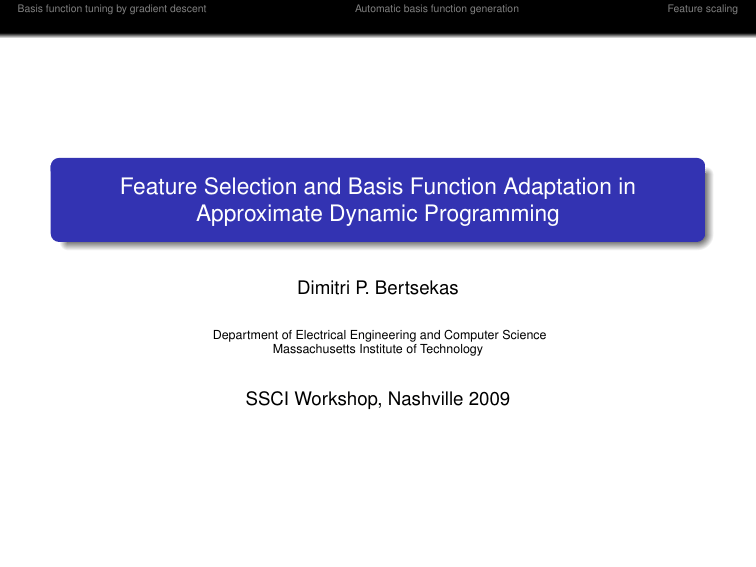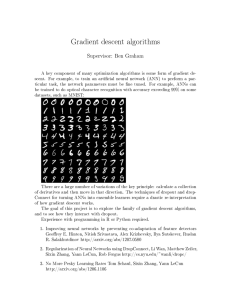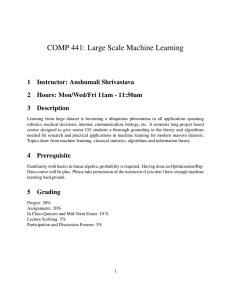Feature Selection and Basis Function Adaptation in
advertisement

Basis function tuning by gradient descent
Automatic basis function generation
Feature Selection and Basis Function Adaptation in
Approximate Dynamic Programming
Dimitri P. Bertsekas
Department of Electrical Engineering and Computer Science
Massachusetts Institute of Technology
SSCI Workshop, Nashville 2009
Feature scaling
Basis function tuning by gradient descent
Automatic basis function generation
DP Context
Markovian Decision Problems (MDP)
n states, transition probabilities depending on control
Policy iteration method; we focus on single policy evaluation
Bellman’s equation:
x = Ax + b
where
b: cost vector
A has transition structure, e.g.
A = αP for discounted problems; α: discount factor
A = P for average cost problems
Feature scaling
Basis function tuning by gradient descent
Automatic basis function generation
Feature scaling
Approximate Policy Evaluation
Approximation within subspace S = {Φr | r ∈ <s }
x ≈ Φr ,
Φ is a matrix with basis functions/features as columns
Projected Bellman equation: x = ΠT (x) or
Φr = Π(AΦr + b)
Long algorithmic history, starting with TD(λ) (Sutton, 1988)
Least squares methods (LSTD, LSPE) are currently more popular
Basis function tuning by gradient descent
Automatic basis function generation
Feature scaling
Focus
Question: How do we select the matrix Φ?
Subject of great importance, yet largely problem-specific, little
understood at present.
We will sample a few issues of interest, and describe some recent work.
Basis function tuning by gradient descent
Automatic basis function generation
Feature scaling
References
H. Yu and D. P. Bertsekas, “Basis Function Adaptation Methods for Cost
Approximation in MDP," IEEE SSCI Conference Proceedings, 2009;
following the paper by I. Menache, S. Manor, and N. Shimkin, Annals of
OR, 2005.
D. P. Bertsekas and H. Yu, “Projected Equation Methods for Approximate
Solution of Large Linear Systems," Journal of Computational and
Applied Mathematics, 2008.
D. P. Bertsekas, “Projected Equations, Variational Inequalities, and
Temporal Difference Methods," LIDS Report, MIT, 2009.
Basis function tuning by gradient descent
Automatic basis function generation
Feature scaling
Overview of Questions Addressed
Basis function tuning by gradient descent
Parametrize approximation subspace/basis functions by vector θ
˘
¯
Sθ = Φ(θ)r | r ∈ <s
Compute the corresponding solution x(θ) of the projected equation
x = Πθ T (x), where Πθ is projection
`
´on Sθ .
Optimize some cost function F x(θ) over θ (e.g., F is the Bellman equation
error).
Automatic basis function generation
Use a Krylov subspace basis for the equation x = Ax + b
Φ = [b Ab A2 b · · · As−1 b]
Problem is that for high-dimensional problems Ak b cannot be computed
We use instead simulation-based samples of Ak b (noisy features)
Feature scaling
For a fixed subspace S, we consider alternative representations
˘
¯ ˘
¯
S = Φr | r ∈ <s = Ψv | v ∈ <s̄
where Φ = ΨB.
Question: How are the popular algorithms for solving projected equations
affected by such feature scaling?
Basis function tuning by gradient descent
Automatic basis function generation
Outline
1
Basis function tuning by gradient descent
2
Automatic basis function generation
3
Feature scaling
Feature scaling
Basis function tuning by gradient descent
Automatic basis function generation
Feature scaling
Basis Function Tuning
Parametrize approximation subspace/basis functions by vector θ
˘
¯
Sθ = Φ(θ)r | r ∈ <s
Compute the corresponding solution x(θ) of the projected equation
x = Πθ T (x), where Πθ is projection on Sθ , with respect to a weighted
Euclidean norm (independent of θ).
Optimize over θ the Bellman equation error:
`
´
F x(θ) = kx(θ) − Ax(θ) − bk2
`
´
Key idea: Compute approximately gradient ∇F x(θ) by simulation and
low-order computation, and use a gradient-based method.
For this we need an expression for the partial derivatives
∂x(θ)
.
∂θj
Basis function tuning by gradient descent
Automatic basis function generation
Computation of
Feature scaling
∂x(θ)
∂θj
We differentiate the projected equation separately with respect to each
component θj of θ
∂x
∂θj
(θ) =
∂Π
(θ)T (x(θ))
∂θj
∂x
+ Π(θ)A ∂θ
(θ)
j
This can be simplified to
∂x
∂θj
(θ) =
∂Φ
(θ)r (θ)
∂θj
∂r
+ Φ(θ) ∂θ
(θ)
j
with Φ(θ)r (θ) = x(θ).
∂r
(θ) of the derivative is the solution of the
The second component Φ(θ) ∂θ
j
“projected" equation
`
´
y = Π(θ) Ay + qj (x)
where the vector qj (x) ∈ Sθ is given by
`
´ `
´ ∂Φ
∂Π
qj (x) = ∂θ
(θ) Ax(θ) + b + Π(θ)A − I ∂θ
(θ)r (θ)
j
j
Basis function tuning by gradient descent
Automatic basis function generation
Feature scaling
Comments
Each partial derivative
equation.
∂x(θ)
∂θj
requires the solution of a separate projected
Each projected equation can be solved by simulation and
low-dimensional calculations.
We could replace T with a multistep Bellman operator T (λ) , λ ∈ (0, 1).
We may use a cost function different than the Bellman error criterion,
e.g.,
X`
´2
F (x(θ)) = 12
Ji − xi (θ) ,
i∈I
where I is a certain small subset of states, and Ji , i ∈ I, are the costs of
the policy at these states calculated directly by simulation.
Potential difficulties: Slow convergence, nonconvex cost/local minima.
Basis function tuning by gradient descent
Automatic basis function generation
Feature scaling
Automatic Generation of Powers of A as Basis Functions
Use Φ whose ith row is
`
´
φ(i)0 = b(i) (Ab)(i) · · · (As−1 b)(i)
(the Krylov subspace basis).
Thus, we use as features finite horizon expected costs, i.e., (Ak −1 b)(i) is
the k -stage vector starting at state i.
Motivation: If A is a contraction, the fixed point of T has an expansion of
the form
∞
X
x∗ =
Ak b
k =0
k
While (A b)(i) is hard to generate, it can be approximated by sampling
(in effect we use noisy features).
Features Ak b may be supplemented with other “noiseless" features.
Basis function tuning by gradient descent
Automatic basis function generation
Feature scaling
Implementation Within TD methods
Simulate the Markov chain to obtain a sequence of states {i0 , i1 , . . .}, as
is usual in TD.
At each generated state ik , we also generate two additional mutually
“independent" sequences
˘
¯
˘
¯
(ik , îk ,1 ), (îk ,1 , îk ,2 ), . . . , (îk ,s−1 , îk ,s ) ,
(ik , ĩk ,1 ), (ĩk ,1 , ĩk ,2 ), . . . , (ĩk ,s , ĩk ,s+1 )
of lengths s and s + 1, respectively, according to the transition
probabilities pij , which are also “independent" of the sequence
{i0 , i1 , . . .}.
The two extra sequences give single sample approximations of the basis
function components b(ik ), (Ab)(ik ), . . . , (As b)(ik ).
The single samples are used in the TD/LSTD/LSPE formulas as if they
were exact averages.
Convergence properties are maintained, but noise in the algorithms is
increased.
Basis function tuning by gradient descent
Automatic basis function generation
Feature scaling
Alternative Representations of Approximation Subspace
For a fixed subspace S, we consider alternative representations
¯
˘
¯ ˘
S = Φr | r ∈ <s = Ψv | v ∈ <s̄
where Φ = ΨB (B is a matrix whose range contains the range of Ψ0 ).
Consider the high-dimensional sequences Φrk and Ψvk generated by TD
methods.
The high-dimensional sequences generated by LSTD and LSPE are
scale-free (do not depend on the representation of S).
The high-dimensional sequences generated by LSPE with direction
scaling are asymptotically scale-free.
The convergence of TD methods does not depend on Φ having full rank!
Basis function tuning by gradient descent
Automatic basis function generation
Feature scaling
Conclusions
Feature selection is an important and multi-faceted problem.
Many researchers have contributed to it, but many challenges remain.
We discussed a few selected approaches and issues.
Much remains to be done ...



